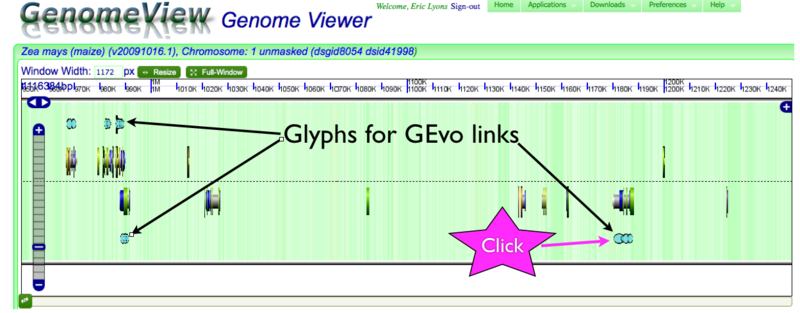MaizeGDB and CoGe: Difference between revisions
uenc |
No edit summary |
||
| Line 44: | Line 44: | ||
Please see [[Maize_Sorghum_Syntenic_dotplot|this page]]. | Please see [[Maize_Sorghum_Syntenic_dotplot|this page]]. | ||
===Thanks=== | |||
Thanks to: | |||
* James Schnable in Michael Freeling's lab at UC Berkeley for generating maize-sorghum [[syntenic gene sets]]. | |||
* [http://www.public.iastate.edu/~taner/ Taner Sen] at the USDA-ARS, Iowa State University for linking MaizeGDB to CoGe and other MaizeGDB specific activities. | |||
Revision as of 01:22, 9 February 2010
Overview
MaizeGDB is linked to CoGe's through its genome browser. A link to CoGe will be shown at the top of the browser when viewing a genomic region from the maize genome assembly (i.e. pseudomolecules). This link will take you to the same region in CoGe's GenomeView. GenomeView will automatically find maize genes with annotations that link to GEvo for syntenic gene sets with sorghum, and show those genes with special glyphs. When you view the annotations for these glyphs (by clicking on them), there will be a link to GEvo. When clicked on, these GEvo links will launch GEvo with the syntenic maize-sorghum regions pre-loaded and automatically start a GEvo analysis using blastz.
MaizeGDB's genome browser link to CoGe's genome broswer, GenomeView

MaizeGDB is one of the leading web resources for accessing genomic information about maize. Information about a maize gene or locus has links to their genome browser (powered by GBrowse of the GMOD project). At the top of the page for browsing the maize genome, is a link to CoGe's genome browser, GenomeView. If you click this link, GenomeView will open at the same genomic region.
GenomeView showing glyphs for genes linked to GEvo

GenomeView can display a variety of genomic information. Here, the background of the virtual chromosome is colored green for GC rich DNA content and white for AT rich DNA content. The dashed line in the middle separates the top and bottoms strands of the genomic DNA duplex. Gene models are drawn as composite colored arrows above and below this line if they are read from the top and bottom strand of the genome respectively. For information about gene models and various visualization in GenomeView, please see this page. Genes with annotations that link to GEvo are displayed above and below the gene models as interlinking blue circles. To get the annotation for any gene or GEvo link, just click on it in GenomeView and a dialog box of its annotations will appear.
Getting a link to GEvo

The dialog box for an annotation in GenomeView will have a line called "GEvo link" and a description of the link to GEvo. Just click on the description of the GEvo link to launch GEvo.
Automatically running GEvo with syntenic maize-sorghum regions pre-loaded

When GEvo is launched, it will automatically have the maize-sorghum syntenic regions pre-loaded using ~400kb of the genome. In addition, it will automatically set the sequences to have all the non-protein coding sequence masked and automatically begin the analysis. Non-protein coding sequences are masked due to the highly repetitive nature of the maize genome. Having many repetitive sequences substantially increases the amount of time it takes for a GEvo analysis to process, the amount of time to render the resulting images, and the difficulty in understanding the results. By default, GEvo will use blastz for comparing these sequences. Blastz is a good algorithm to use when identifying large blocks of similar sequences.
- For information on different alignment algorithms, please see this page.
- For information on how to link to GEvo and set various parameters from the URL, please see this page.
GEvo's results

When the results from GEvo are returned, you will a panel for each of the genomic regions returned. These images are interpreted similarly as to those in GenomeView, however you will notice that the background of the chromosomes will have a lot of purple. This represents genomic sequence that was masked from the analysis (in this case, non-protein coding sequence). Also, there will be colored blocks located above and below the gene models. These blocks are regions of sequence similarity identified for pairwise comparisons of the genomic regions. If you click on one of these blocks a transparent wedge will be drawn connecting it to its partner region. By clicking on many of these (or holding the 'shift' key then click on one to connect all of them from a given track), you can detect various patterns of genome evolution.
More help and examples
If you are interested in:
- Whole genome comparisons of maize and sorghum
- Identifying syntenic regions
- Differentiating syntenic regions derived from the:
- maize-specific whole genome duplication event
- the divergence of the maize and sorghum lineages
- the pre-grass whole genome duplication event
- Identifying patterns of genome fractionation
- Identifying conserved non-coding sequences
Please see this page.
Thanks
Thanks to:
- James Schnable in Michael Freeling's lab at UC Berkeley for generating maize-sorghum syntenic gene sets.
- Taner Sen at the USDA-ARS, Iowa State University for linking MaizeGDB to CoGe and other MaizeGDB specific activities.